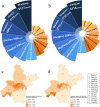The comparison of epidemiological characteristics between confirmed and clinically diagnosed cases with COVID-19 during the early epidemic in Wuhan, China
- PMID: 34049599
- PMCID: PMC8161348
- DOI: 10.1186/s41256-021-00200-8
The comparison of epidemiological characteristics between confirmed and clinically diagnosed cases with COVID-19 during the early epidemic in Wuhan, China
Abstract
Background: To put COVID-19 patients into hospital timely, the clinical diagnosis had been implemented in Wuhan in the early epidemic. Here we compared the epidemiological characteristics of laboratory-confirmed and clinically diagnosed cases with COVID-19 in Wuhan.
Methods: Demographics, case severity and outcomes of 29,886 confirmed cases and 21,960 clinically diagnosed cases reported between December 2019 and February 24, 2020, were compared. The risk factors were estimated, and the effective reproduction number (Rt) of SARS-CoV-2 was also calculated.
Results: The age and occupation distribution of confirmed cases and clinically diagnosed cases were consistent, and their sex ratio were 1.0 and 0.9, respectively. The epidemic curve of clinical diagnosis cases was similar to that of confirmed cases, and the city centers had more cumulative cases and higher incidence density than suburbs in both of two groups. The proportion of severe and critical cases (21.5 % vs. 14.0 %, P < 0.0001) and case fatality rates (5.2 % vs. 1.2 %, P < 0.0001) of confirmed cases were all higher than those of clinically diagnosed cases. Risk factors for death we observed in both of two groups were older age, male, severe or critical cases. Rt showed the same trend in two groups, it dropped below 1.0 on February 6 among confirmed cases, and February 8 among clinically diagnosed cases.
Conclusions: The demographic characteristics and spatiotemporal distributions of confirmed and clinically diagnosed cases are roughly similar, but the disease severity and clinical outcome of clinically diagnosed cases are better than those of confirmed cases. In cases when detection kits are insufficient during the early epidemic, the implementation of clinical diagnosis is necessary and effective.
Keywords: COVID-19; Clinical diagnosis; Effective reproduction number; Epidemiology; Risk factor; Wuhan city.
Conflict of interest statement
The authors declare that they have no competing interests.
Figures




Similar articles
-
Association of Public Health Interventions With the Epidemiology of the COVID-19 Outbreak in Wuhan, China.JAMA. 2020 May 19;323(19):1915-1923. doi: 10.1001/jama.2020.6130. JAMA. 2020. PMID: 32275295 Free PMC article.
-
[Epidemiological characteristics of COVID-19 in Wuchang district of Wuhan].Zhonghua Liu Xing Bing Xue Za Zhi. 2020 Oct 10;41(10):1616-1622. doi: 10.3760/cma.j.cn112338-20200412-00565. Zhonghua Liu Xing Bing Xue Za Zhi. 2020. PMID: 33297617 Chinese.
-
Epidemiology of COVID-19 in older persons, Wuhan, China.Age Ageing. 2020 Aug 24;49(5):706-712. doi: 10.1093/ageing/afaa145. Age Ageing. 2020. PMID: 32584953 Free PMC article.
-
Epidemiological and clinical characteristics analysis of COVID-19 in the surrounding areas of Wuhan, Hubei Province in 2020.Pharmacol Res. 2020 Jul;157:104821. doi: 10.1016/j.phrs.2020.104821. Epub 2020 Apr 30. Pharmacol Res. 2020. PMID: 32360481 Free PMC article.
-
Evolving epidemiology and transmission dynamics of coronavirus disease 2019 outside Hubei province, China: a descriptive and modelling study.Lancet Infect Dis. 2020 Jul;20(7):793-802. doi: 10.1016/S1473-3099(20)30230-9. Epub 2020 Apr 2. Lancet Infect Dis. 2020. PMID: 32247326 Free PMC article.
Cited by
-
Using the SEIQR model with epidemic amplifier effect to predict the final outbreak size of the COVID-19 in Dalian, Liaoning province, China.PLoS One. 2024 Dec 12;19(12):e0307239. doi: 10.1371/journal.pone.0307239. eCollection 2024. PLoS One. 2024. PMID: 39666686 Free PMC article.
-
Medical implementation practice and its medical performance evaluation of a giant makeshift hospital during the COVID-19 pandemic: An innovative model response to a public health emergency in Shanghai, China.Front Public Health. 2023 Jan 6;10:1019073. doi: 10.3389/fpubh.2022.1019073. eCollection 2022. Front Public Health. 2023. PMID: 36684897 Free PMC article.
-
Risk factors for poor prognosis in children and adolescents with COVID-19: A systematic review and meta-analysis.EClinicalMedicine. 2021 Nov;41:101155. doi: 10.1016/j.eclinm.2021.101155. Epub 2021 Oct 19. EClinicalMedicine. 2021. PMID: 34693233 Free PMC article.
-
Emergency Preparedness and Management of Mobile Cabin Hospitals in China During the COVID-19 Pandemic.Front Public Health. 2022 Jan 3;9:763723. doi: 10.3389/fpubh.2021.763723. eCollection 2021. Front Public Health. 2022. PMID: 35047472 Free PMC article. Review.
References
-
- WHO. Naming the coronavirus disease (COVID-19) and the virus that causes it. https://www.who.int/emergencies/diseases/novel-coronavirus-2019/technica.... Accessed 19 Feb 2020.
-
- Wang X, Yu Y, Hu Y, Yu C. COVID-19 analysis and forecast based on exponential smoothing model in Hubei Province (in Chinese). J Public Health Prev Med. 2020;30(1):1-4.
-
- National health commission of the People’s Republic of China. Notice on guideline over the diagnosis and treatment of COVID-19 (Revision version fifth). http://www.nhc.gov.cn/yzygj/s7653p/202002/d4b895337e19445f8d728fcaf1e3e1.... Accessed 8 Feb 2020.
Publication types
MeSH terms
Grants and funding
LinkOut - more resources
Full Text Sources
Other Literature Sources
Medical
Miscellaneous

